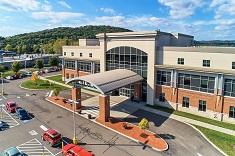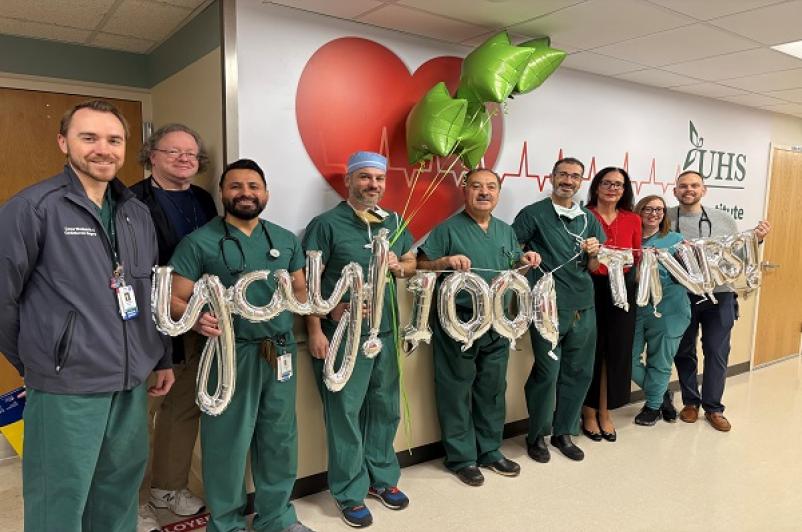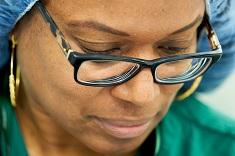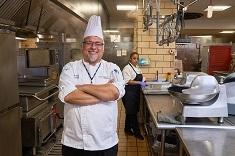

The 1,000th TAVR procedure: A milestone of expertise and trust
February 24, 2025
The UHS Heart & Vascular Institute recently celebrated a significant milestone with the completion of their 1,000th TAVR (Transcatheter Aortic Valve Replacement) procedure. This achievement is more than a number – it represents improved quality of life for patients who have aortic valve stenosis. For Barbara McDevitt, our 1,000th TAVR patient, it represents continuing a healthy and active life.
Every year, Barbara receives an echocardiogram to monitor her heart. In June 2024, she had one done at her local hospital, and the results showed a severe aortic valve stenosis, a condition where the leaflets of the aortic valve between the heart’s left ventricle and the aorta do not open properly, preventing blood from flowing normally. Barbara was shocked by this diagnosis, as she had never experienced any symptoms. Some symptoms that may occur are chest pain or tightness, shortness of breath and fatigue, especially during physical activity. She had always been an active woman throughout her life, going for walks, cooking for her family and attending family gatherings.
“I had been in the moderate stage for aortic valve stenosis for several years, so to hear that it went from moderate to severe was scary to me. The fact that I didn’t have any symptoms was interesting,” said Mrs. McDevitt.
After discussing her diagnoses, Barbara’s provider recommended going to Alon Yarkoni, MD, FACC, Director of the UHS Structural Heart Program, for a TAVR procedure. This procedure is an alternative to open-heart surgery, allowing a catheter to replace the heart valve through a small incision in the groin area instead of surgically opening the chest, making it minimally invasive. The new valve is inserted within the diseased aortic valve, pushing aside the leaflets of the old valve and securing the new valve frame in place.
One of Barbara’s friends had the same procedure and spoke highly of the care he received from UHS. The TAVR procedure involves a multidisciplinary team of healthcare professionals, including implanting cardiologists, heart surgeons, Cath-Lab nurses, radiology technicians and anesthesiologists. To ensure a smooth recovery following the procedure, a dedicated team of physicians and nurse practitioners provide care from the recovery room to the time of discharge.
Initially, Barbara was hesitantto undergo the procedure, as she had no symptoms and had witnessed her parents experience complications following their surgeries. She shared her concerns with UHS Clinic Coordinator Nicole Schneider, RN, who took the time to thoroughly explain the process. Nicole’s detailed explanation helped ease Barbara’s worries and ultimately convinced her to move forward with the TAVR procedure.
Mrs. McDevitt explained, “It was a difficult decision for me because I didn’t feel sick. I’ve been very fortunate that I never stayed overnight for surgery. After learning more about the TAVR procedure, I realized I should have it done before my health worsens and I find myself in a more urgent situation.”
On the morning of the procedure, Nicole visited Barbara to offer her support. “I was nervous, but Nicole stopped by before my procedure to reassure me once again. My husband and I truly appreciated her taking the time to do that. She is so kind and understanding,” said Mrs. McDevitt. After Nicole’s visit, Barbara was confident about going through the procedure. Her surgery went smoothly and lasted about 45 minutes. Barbara was discharged by the afternoon the following day.
Following the procedure, UHS Cardiology Nurse Practitioner Kristen Lewis, FNP, helped Barbara with the post-procedure recovery care and prescribed antiplatelet medications. Barbara was directed to take Plavix for three months and a daily low-dose aspirin. These antiplatelet medications help prevent blood clots from forming in the bloodstream and around heart valves. Most TAVR patients take a daily low-dose aspirin as part of their long-term care, as it can help lower the risk of complications such as heart attacks and strokes.
Earlier this year, Barbara had a follow-up echocardiogram appointment with Kristen to monitor her recovery and to ensure her new valve was functioning properly. The results confirmed that the TAVR procedure was successful in treating the diseased aortic valve, allowing for improved blood flow and heart function. Barbara felt reassured that her recovery was progressing well.
Reflecting on her care, Mrs. McDevitt shared, “Kristen is an integral part of the TAVR team. Every time I met with Kristen, she was informative and reassuring. She was always kind and took the time to answer all my questions during my visits.”
Barbara continues to live an active lifestyle, enjoying time with family and embracing simple pleasures like cooking and walking. She expresses how important it is to continue to stay active. “I never stopped doing what I enjoyed before my surgery because I didn’t have any symptoms. However, I plan to walk more and be more diligent about exercising. It’s important to stay active, especially after this procedure.”
While Barbara never expected to be the 1,000th patient, she was happy to know she had a doctor who had extensive TAVR experience and knowledge. “I was very happy. I felt confident it would be successful because Dr. Yarkoni had performed so many procedures before mine. I was confident in him and his work.” The idea of being part of such a significant milestone for Dr. Yarkoni and his team gave her added reassurance. This milestone represents a deep level of trust from his patients.
Dr. Yarkoni and his team were the first in the Southern Tier to perform the TAVR procedure, occurring at UHS Wilson Medical Center in December 2014. The 1,000th TAVR procedure is a testament of the level of expertise and high-quality care offered at UHS right here in the Greater Binghamton area. “The TAVR program has been rewarding to direct and to watch it grow over the last ten years. It has helped many people in our community, and I am proud of our team for making this a successful program,” said Dr. Yarkoni.
If you would like to learn more about our heart care services at the UHS Heart & Vascular Institute, please click here.

